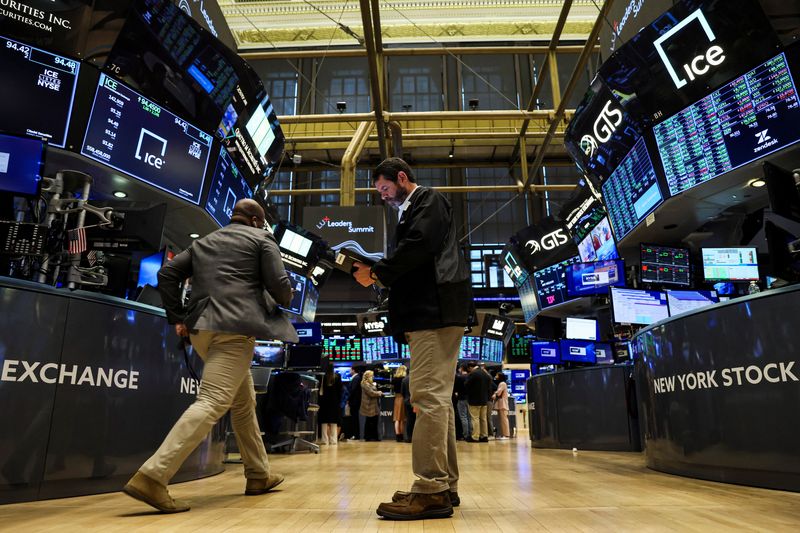By Chuck Mikolajczak
NEW YORK (Reuters) – U.S. stocks closed lower for a fourth consecutive session on Thursday as economic data did little to alter expectations the Federal Reserve would continue raising interest rates for longer than previously thought.
Following the Federal Reserve’s statement on Wednesday, comments from Fed Chair Jerome Powell that it was “very premature” to be thinking about pausing its rate hikes sent stocks lower as U.S. bond yields and the U.S. dollar rose, a pattern that extended into Thursday.
Economic data on Thursday showed a labor market that continues to stay strong, although a separate report showed growth in the services sector slowed in October, keeping the Fed on its aggressive interest rate hike path.
(Graphic: Jobless claims and Challenger Gray, https://graphics.reuters.com/USA-STOCKS/zdpxdywdmpx/joblessclaims.png)
“Years ago the Fed’s job was to take away the punch bowl and that balance is always a very difficult transition, you want the economy to slow to keep inflation from getting out of hand but you want enough earnings to support stock prices,” said Rick Meckler, partner at Cherry Lane Investments in New Vernon, New Jersey.
“It is about the rate of change as much as the change so when the rate of change starts to slow … that almost becomes a positive even though in absolute terms we are going to continue to see higher rates, and higher rates means more competition for stocks and lower multiples.”
The Dow Jones Industrial Average fell 146.51 points, or 0.46%, to 32,001.25, the S&P 500 lost 39.8 points, or 1.06%, to 3,719.89 and the Nasdaq Composite dropped 181.86 points, or 1.73%, to 10,342.94.
While traders are roughly evenly split between the odds of a 50 basis-point and 75 basis-point rate hike in December, the peak Fed funds rate is seen climbing to at least 5%, compared with a prior view of a rise to the 4.50%-4.75% range.
Investors will closely eye the nonfarm payrolls report due on Friday for signs the Fed’s rate hikes are beginning to have a notable impact on slowing the economy.
The climb in yields weighed on megacap growth companies such as Apple Inc (NASDAQ:AAPL), down 4.24%, and Alphabet (NASDAQ:GOOGL) Inc, which lost 4.07% and pulled down the technology and communication services sectors as the worst-performing on the session.
Losses were curbed on the Dow thanks to gains in industrials including Boeing (NYSE:BA) Co, which rose 6.34%, and a 2.20% climb in heavy equipment maker Caterpillar Inc (NYSE:CAT).
Qualcomm (NASDAQ:QCOM) Inc and Roku (NASDAQ:ROKU) Inc shed 7.66% and 4.57%, respectively, after their holiday quarter forecasts fell below expectations.
With roughly 80% of S&P 500 companies having reported earnings, the expected growth rate is 4.7%, according to Refinitiv data, up slightly from the 4.5% at the start of October.
Volume on U.S. exchanges was 11.81 billion shares, compared with the 11.63 billion average for the full session over the last 20 trading days.
Declining issues outnumbered advancing ones on the NYSE by a 1.75-to-1 ratio; on Nasdaq, a 1.50-to-1 ratio favored decliners.
The S&P 500 posted 6 new 52-week highs and 46 new lows; the Nasdaq Composite recorded 77 new highs and 291 new lows.
We encourage you to use comments to engage with other users, share your perspective and ask questions of authors and each other. However, in order to maintain the high level of discourse we’ve all come to value and expect, please keep the following criteria in mind:
Perpetrators of spam or abuse will be deleted from the site and prohibited from future registration at Investing.com’s discretion.

